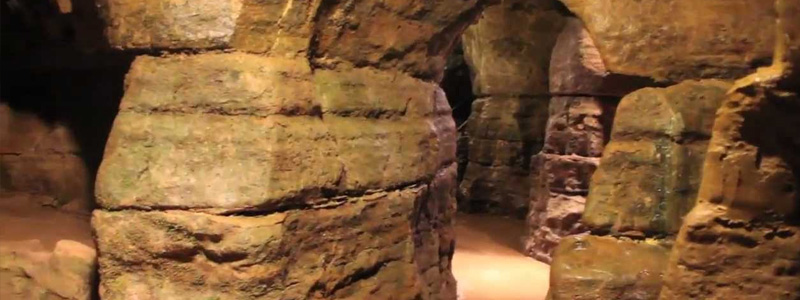A Journey to the Ice Age and Look into the Future
Filled with geological wonders, Indian Trail Caverns and Sheridan Cave in northwest Ohio hold the keys to prehistoric information as well as a worthwhile adventure.
Indian Trail Caverns sits on a high ridge in an otherwise incredibly flat terrain on the outskirts of the small town of Carey in the northwest part of Ohio. It’s possible to drive right past the small and unassuming entrance on the two-lane State Route 568. It’s also hard to imagine multiple film crews from Discovery Channel, National Geographic Channel, or NOVA, as well as world-famous archeologists, coming to this tiny spot to film and research. But what lies beneath the unobtrusive entrance is truly remarkable.
History of Indian Trail Caverns & Sheridan Cave
Formed during the last Ice Age, the great glaciers pushed tons of ice, snow, dirt, and rock across the landscape, south from Canada. Melting water rushed down through the ground and created underground glacial rivers that carved out the caverns. In 1927, the ground opened up during an earthquake and revealed the caverns hidden below. The name Indian Trails comes from the fact that the caverns are part of a network of caves that were used by the Wyandot Indians. Cave drawings can be seen on the ceiling near what is called the Indian Council Chamber, as well as stone ladder entrances and several smoke holes. Natural skylights provided light into the caverns, which at their deepest now are about 4 stories underground.
Significance of Indian Trail Caverns in History
The archaeological site has yielded over thirteen thousand different specimens and artifacts, more than seventy species of paleo plants and animals which lived in the Ohio region before the last glacial coverage. Rare extinct species found at the site include short-faced bear, elk-moose, flat-headed and long-nosed peccary.
Of particular interest is the giant beaver, which was more than six feet long and weighed over 250 pounds. As the last place the giant beaver has been determined to live on earth, Indian Trail Caverns and Sheridan Cave were featured in the 2002 Discovery Channel documentary What Killed the Mega Beasts.
The Black Mat
But there is another interesting and historical discovery here too. The Black Mat, as it is called, is a layer of asteroid dust that dates back 13,000 years and is present in the Sheridan Cave excavation on the site. The layer is filled with what some scientists suspect is debris from a large asteroid impact. It is believed that the earth passes through the debris of Saturn every 13,000 years, alternating northern and southern hemisphere impacts. Some people believe this theory is tied to the Mayan calendar, which shows significant historical elements and future predictions based on this time frame. The theory has created a wave of media interest in the December 2012 date which is also tied to the fact that on the winter solstice in 2012, the sun will be aligned with the center of the Milky Way for the first time in about 26,000 years.
When to Visit Indian Trail Caverns
Indian Trail Caverns is open Memorial Day to Labor Day on weekend afternoons, from 1:00 to 5:00 PM. Guided tours last about 45 minutes and the cost is $7 for adults, $5 for children and preschoolers are free. The walk down the steps is a bit slick, tennis shoes or walking boots are suggested. The temperature in the cave remains approximately 52 degrees Fahrenheit year-round, so a light jacket is recommended.
Group tours are available with special rates from March to October by calling (419) 387-7773 or visiting the website at www.indiantrailcaverns.com.
Indian Trail Caverns
722 OH-568, Carey, OH 43316
Phone: (419) 387-7773

